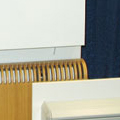
Jaga’s Raf Moors displays some of his company’s low-mass, low-water
temperature radiators at the RPA trade show in Reno.
Better insulation in modern construction has made it feasible to heat buildings with lower-temperature water, saidRaf Moors, U.S. manager forJaga, a manufacturer of low-mass radiators. He made his case to members of the Radiant Panel Association in a seminar, “Ultra Low Mass Low Temperature Radiant Heating,” May 7 during RPA’s national convention in Reno, Nev.
“The key question is how we provide low-water temperature to provide comfortable heat in our living space,” Moors told RPA members. “The building envelope has changed so a high-mass system no longer is needed. A low-mass system will allow you to respond immediately to a change in the temperature.”
For ultimate heating comfort, however, radiant floor heating can be combined with low-mass radiators, Moors said. With no heat storage in the radiators, the units heat up and cool down much faster. This allows building occupants to heat the room only when necessary, and not when they are asleep or at work.
Designed with a larger contact area between copper tube and corrugated aluminum fin, low-mass radiators operate on a supply water temperature starting from 110 degrees F. These radiators contain only 10% of the water content compared with a panel radiator with identical heat output. Laminar airflow provides optimal convection.
Since low-mass radiators are designed to work on lower water temperatures, they allow a condensing boiler to work always in condensing mode. Heat pumps and solar panels can be installed to work with these units.
When selecting a low-mass radiator, contractors and engineers should make sure the unit’s minimal output covers the heat losses of the room on a design condition day, Moors said. A radiator with more power reduces the required heat-up time, which reduces energy consumption.
“Therefore, a low-mass radiator can never be oversized, unlike a boiler!” he explained.
Moors told RPA members to install the radiators in areas with the highest energy losses, such as in front of windows and against outer walls.
“Radiation goes through these surfaces and causes direct energy loss,” he said. “Convection creates a curtain of warm air in front of these surfaces and generates a barrier for the losses.”
During his seminar, Moors cited a test that compared heating systems in two nearly identical rooms. A radiant floor system heated one room; a radiant floor system and low-mass radiator heated the other. The study found:
- The low-mass radiator was able to work as the main heating
system with low water temperature.
- The radiator saved energy by enabling a lower night
temperature.
- The radiator offered optimal comfort by reacting accurately to every
change in heat demand.
- The room with the radiator suffered less from overheating caused by
sunshine. The low-mass radiator’s reaction time on variable heating demand is
faster than with any other heating system.
- Due to the low water temperature, both low-mass radiators and
radiant floor heating can be combined with condensing boilers and sustainable
energy sources such as heat pumps and solar cells. Both systems can be used as
the main room heating under these conditions.
- The low-mass radiator offered comfort, a quick response on variations in heating demand and the highest energy savings over the whole day.
Jaga will sponsor aModern Engineering Concepts Webinarat 1 p.m. (Eastern) Sept. 8, produced by BNP Media and presented bypmeHydronics EditorJohn Siegenthaler. “Ultra-Low Mass Hydronic Heat Emitters: An Ideal Scenario for Low Energy Use Buildings” will last 90 minutes and costs $79 to attend (early-bird rate of $49 until Aug. 25).
Visithttp://webinars.pmengineer.comto register.

